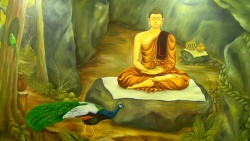Renaming the Ten Dharma Realms
The ten dharma realms smack of religiosity. Whenever I tell my friends that Buddhism is not a religion of blind belief but a rational system of mental cultivation practices, they say: But your website speaks of hell realms, hungry ghosts and other such religious-sounding, old-fashioned things.
They are correct. However, although Master Hsuan Hua speaks of the hell realms, he makes it clear that he is speaking of the mental state of sadness, despair, and all that other bad stuff. And he makes it clear that the cultivation of happiness is the antidote for that realm.
It’s time to drop religious-sounding terms from Buddhism. Why even speak of the hell realms? Why not just speak of the Buddhist practice of cultivating happiness as the first step of practice? (at howtopraticezen.com, this translates into the practice taught by Master Hakuin).
And if the hungry ghosts of the ninth dharma realm are just embodiments of hatred and anger, as Master Hua teaches, why do we even need to mention them? We can instead speak of the cultivation of loving kindness as the second step of practice.
If the eighth dharma realm of animals is created by intense greed, as Master Hua teaches, and if its antidote is the practice of generosity, perhaps we can just recommend the cultivation of giving, which can take many forms other than the mere writing of checks, without tying that practice to leaving the dharma realm of animals.
The remaining dharma realms do not have clear antidotes as do the three lowest realms, but it is not difficult to invoke the Buddha’s teaching of the Four Foundations of Mindfulness to the next four realms.
Thus, the peace-generating practice for countering the seventh dharma realm of the asuras, the fighting gods, is mindfulness of the body. To even suggest that this weird dharma realm exists is to invite extreme skepticism. It makes more sense to teach the four steps of mindfulness of the body as enunciated by the Buddha in the Anapanasati Sutta without even mentioning the dharma realm that is transcended by such practice.
The desire-lessening practice for countering the desire to remain in the sixth dharma realm of humans is mindfulness of feelings.
The practice that reduces our attachment to the lower six worlds of the desire realm and which lifts us from the fifth dharma realm of the gods of the lower six worlds – another dharma realm that strikes modern people as bizarre – is mindfulness of the mind.
The practice that lifts us from the fourth dharma realm of the Arhats and the fetter of the desire to remain in the world of form is mindfulness of mind objects.
It is easier to teach these meditations on the four foundations of mindfulness as simply cultivation practices than to explain them as freeing the practitioner from the seventh, sixth, fifth and fourth dharma realms.
The third dharma realm of the Pratyeka Buddhas, transcended by realization, backwards and forwards, of the twelve links of dependent origination, is exceptionally hard to explain to newcomers to Buddhism. The ancient texts explain that a Pratyeka Buddha is self-taught when there is no Buddha in the world and if there is a Buddha in the world, the Pratyeka Buddha becomes enlightened upon hearing the teachings of the Buddha.
It is easier for a teacher to simply teach the twelve links without tying them to the third dharma realm and the fetter of the desire to remain in the formless world. But we can never forget that the Buddha taught that no one attains enlightenment who has not seen the twelve links forwards and backwards. A cultivation program that omits the twelve links omits a critical link.
And the same applies to the second dharma realm of the Bodhisattvas. The practice associated with this dharma realm is the solving of koans, aided by the mindfulness developed in the previous steps.
The Buddhas of the first dharma realm are teachers and that is not so hard to explain. But how do we explain what a Buddha is?
So we only need to rename the eight lower dharma realms: The dharma realms of sadness, hatred, greed, fighting, sense desire, desire to remain in the six worlds, desire to remain in the world of form, and desire to remain in the formless world. The top two dharma realms, that of the Bodhisattva and the Buddha are best left alone.
As new practitioners become mature in their practices, they can learn of the correlation of the practices and the dharma realms.
But when speaking to non-Buddhists, I no longer mention the dharma realms because most people find them to be religious creations. Far better, I have found, to speak of practices that cultivate happiness, loving kindness, and generosity.
And it is difficult to speak of practices that generate peace, reduction of sense desire, lessening of the desire to remain in the world of sense desire, and lessening of the desire to remain the world of form. Far easier just to share the four foundations of mindfulness as taught by the Buddha.
So here’s a haiku, in the required 5 syllables, 7 syllables, 5 syllables format, that I give to new cultivators so that they can remember the practices without getting bogged down in dharma realm definitions that strike modern people as being just plain weird:
Happy, kind, giving, Form, feeling, mind, mind objects, Twelve links, koans, teach.
This haiku does not expressly invoke the ten dharma realms. But to those who know them, the one-to-one correspondence with each word and its dharma realm is real, just as real as are the dharma realms themselves.


